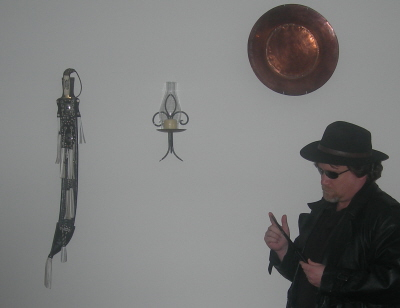|
About This Author
Come closer.
|
Complex Numbers
Complex Numbers
A complex number is expressed in the standard form a + bi, where a and b are real numbers and i is defined by i^2 = -1 (that is, i is the square root of -1). For example, 3 + 2i is a complex number.
The bi term is often referred to as an imaginary number (though this may be misleading, as it is no more "imaginary" than the symbolic abstractions we know as the "real" numbers). Thus, every complex number has a real part, a, and an imaginary part, bi.
Complex numbers are often represented on a graph known as the "complex plane," where the horizontal axis represents the infinity of real numbers, and the vertical axis represents the infinity of imaginary numbers. Thus, each complex number has a unique representation on the complex plane: some closer to real; others, more imaginary. If a = b, the number is equal parts real and imaginary.
Very simple transformations applied to numbers in the complex plane can lead to fractal structures of enormous intricacy and astonishing beauty.
November 24, 2023 at 8:37am November 24, 2023 at 8:37am
| |
Today's article isn't going to turn anyone into an expert. Perhaps it provides more approachable metaphors for concepts entirely alien to our experience. From Scientific American, though I'll note it's "opinion" and not "fact:"
On the face of it, however, the quantum realm is extraordinary: Within it, quantum objects can be “in two places at once”; they can move through barriers; and share a connection no matter how far apart they are.
What someone needs to do now is write a quantum romance novel. "Edith, we share a connection no matter how far apart we are." "Katy, I would tunnel through a barrier to reach you." "Now that I have the quantum power to be in two places at once, I can have my Kate and Edith, too!"
Sigh. I guess that someone will have to be me.
Compared to what you would expect of, say, a tennis ball, their properties are certainly weird and counterintuitive.
The truly weird and counterintuitive part is that those properties are (as far as we know) the fundamental reality, while our balls possess emergent properties that we've evolved to be able to understand. This doesn't make macroscopic reality an illusion, however.
But don’t let this scare you off!
Nah, it's usually the math that scares people off. Fear not; there's none in the article, or in this entry.
Much of quantum physics’ odd behavior becomes a lot less surprising if you stop thinking of atoms and electrons as minuscule tennis balls, and instead imagine any “quantum object” as something like a wave you create by pushing your hand through water. You could say that, at small scales, everything is made of waves.
One emergent property seems to be stuff. Matter, I mean. Which doesn't mean quantum physics doesn't matter.
Imagine throwing a tennis ball. If we wanted to, we could track the ball’s exact position and velocity throughout its flight.
Not only that, but we can predict its path to any accuracy we want, using classical (Newtonian) physics. Well, at least, assuming it's a perfectly smooth and symmetrical sphere, moving through a vacuum. But who plays tennis in a vacuum?
The issue with subatomic particles isn't a matter of having to deal with difficult factors like air density or wind, though.
Strangely enough, if we were to shrink the ball down to the size of, say, an atom, this kind of tracking becomes impossible.
This is metaphorical. Despite what the MCU would have us believe, we can't shrink a collection of atoms down to the size of a single atom.
This limitation is called Heisenberg’s uncertainty principle.
And it led to one of my favorite puns: A plaque on a wall reading "Heisenberg may have slept here." I'm still salty that Breaking Bad ruined that pun because no one thinks of the physicist when they hear that name.
The article, of course, explains uncertainty with some certainty.
A quantum object can “be in two places at once” by being in a so-called superposition of states. Thinking about waves, this is no surprise. A wave can be in two places at once. If you send a wave down a forked channel, it will easily split and flow through both channels at the same time.
I'm not certain this is a helpful analogy. We think of such waves as separate entities after the split. Still, I'm no expert, and I understand they're trying to illuminate the counterintuitive. Just so long as we don't consider this an exact analogy, it's probably fine in terms of how to think about it without using math.
Again, more detail at the article, along with a nice salad dressing recipe.
Another seemingly peculiar feat of quantum objects is that with some probability they can pass through barriers. This is called tunneling.
I've known about this property for some time, and even done some of the math involved. What I'm not clear on is this: using their favored tennis ball analogy, what you have is a tennis ball and a wall. Both are macroscopic objects, made of matter, pretty much solid in our perception, each containing an incomprehensibly high number of atoms. But if you zoom in to atomic scale, you not only can't think of the atom as a tennis ball, but you can't think of the barrier as a collection of even smaller atoms making up a solid wall. I guess it's something to do with energy levels, but I could be wrong.
But physicists aren't unclear on this stuff. Just me. As before, it's an imperfect analogy.
In some cases, a water wave can move through a barrier just like a quantum particle, something you can demonstrate in your bathtub. To do so, build an underwater wall in the tub, one tall enough that it almost touches the water’s surface, but not quite. If you send a wave at this wall at a glancing angle, it will always bounce back from the wall. This is analogous to so-called total internal reflection of light rays.
I have better things to do in the bathtub.
Incidentally, however, this is part of the physics behind fiber optics.
The same phenomenon of “broken” total internal reflection, but with light rays instead of water waves, is used in certain types of touch screen displays.
And those.
Anyway, the last bit of the article talks about one example of this analogy not working. But to break your mind even further, when physicists talk about waves at the quantum level, it's my (limited) understanding that what they're really talking about is a probability wave.
Which goes back to mystifying the whole thing. |
© Copyright 2025 Robert Waltz (UN: cathartes02 at Writing.Com). All rights reserved.
Robert Waltz has granted InkSpot.Com, its affiliates and its syndicates non-exclusive rights to display this work.
|

